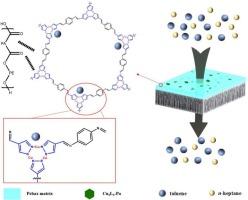Cu(I)-COF facilitated transport membranes for aromatics-alkanes separation
IF 4.3
2区 工程技术
Q2 ENGINEERING, CHEMICAL
引用次数: 0
Abstract
Separating aromatic and aliphatic hydrocarbons can produce high-quality cracking feedstocks and recover value-added aromatic products. Covalent organic framework (COF) may find promising application owing to its exceptional structures and functionalities. In this study, Cu(I)-COF was designed and integrated into Pebax matrix to fabricate facilitated transport membranes. The immobilization of Cu(I) ions onto the COF framework effectively mitigates leaching. Additionally, the COF building blocks provides a stable electron cloud environment for Cu(I), ensuring long-term stability for over 6 months. The vertical channels in the COF afford rapid mass transfer, and the uniformly distributed Cu(I) enhances toluene affinity, thereby intensifying the transfer of toluene. For a 50 wt% toluene/n-heptane mixture, the Cu3L3-Pa-Pebax-2 membrane demonstrated a permeation flux of 1100 g·m−2·h−1 and a separation factor of 5.44. This study provides a new example for the application of multifunctional organic framework materials to fabricate facilitated transport membranes.


Cu(I)-COF促进了芳烃-烷烃分离的传输膜
分离芳烃和脂肪烃可以生产高质量的裂解原料,回收高附加值的芳烃产品。共价有机骨架(COF)由于其独特的结构和功能,具有广阔的应用前景。在本研究中,Cu(I)-COF被设计并集成到Pebax基质中,以制备促进运输膜。Cu(I)离子在COF框架上的固定化有效地减缓了淋溶。此外,COF构建块为Cu(I)提供了稳定的电子云环境,确保了超过6 个月的长期稳定性。COF内垂直通道快速传质,Cu(I)的均匀分布增强了对甲苯的亲和力,从而强化了甲苯的传递。对于浓度为50 wt%的甲苯/正庚烷混合物,Cu3L3-Pa-Pebax-2膜的渗透通量为1100 g·m−2·h−1,分离系数为5.44。本研究为多功能有机骨架材料在制备易转运膜方面的应用提供了新的范例。
本文章由计算机程序翻译,如有差异,请以英文原文为准。
求助全文
约1分钟内获得全文
求助全文
来源期刊

Chemical Engineering Science
工程技术-工程:化工
CiteScore
7.50
自引率
8.50%
发文量
1025
审稿时长
50 days
期刊介绍:
Chemical engineering enables the transformation of natural resources and energy into useful products for society. It draws on and applies natural sciences, mathematics and economics, and has developed fundamental engineering science that underpins the discipline.
Chemical Engineering Science (CES) has been publishing papers on the fundamentals of chemical engineering since 1951. CES is the platform where the most significant advances in the discipline have ever since been published. Chemical Engineering Science has accompanied and sustained chemical engineering through its development into the vibrant and broad scientific discipline it is today.
 求助内容:
求助内容: 应助结果提醒方式:
应助结果提醒方式:


